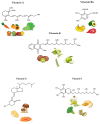The Biological Role of Vitamins in Athletes' Muscle, Heart and Microbiota
- PMID: 35162272
- PMCID: PMC8834970
- DOI: 10.3390/ijerph19031249
The Biological Role of Vitamins in Athletes' Muscle, Heart and Microbiota
Abstract
Physical activity, combined with adequate nutrition, is considered a protective factor against cardiovascular disease, musculoskeletal disorders, and intestinal dysbiosis. Achieving optimal performance requires a significantly high energy expenditure, which must be correctly supplied to avoid the occurrence of diseases such as muscle injuries, oxidative stress, and heart pathologies, and a decrease in physical performance during competition. Moreover, in sports activities, the replenishment of water, vitamins, and minerals consumed during training is essential for safeguarding athletes' health. In this scenario, vitamins play a pivotal role in numerous metabolic reactions and some muscle biochemical adaptation processes induced by sports activity. Vitamins are introduced to the diet because the human body is unable to produce these micronutrients. The aim of this review is to highlight the fundamental role of vitamin supplementation in physical activity. Above all, we focus on the roles of vitamins A, B6, D, E, and K in the prevention and treatment of cardiovascular disorders, muscle injuries, and regulation of the microbiome.
Keywords: athletic performance; cardiac pathologies; gut microbiota; micronutrients; muscle damage; nutrition.
Conflict of interest statement
The authors declare no conflict of interest.
Figures




Similar articles
-
Nutrition and sports performance.Sports Med. 1984 Sep-Oct;1(5):350-89. doi: 10.2165/00007256-198401050-00003. Sports Med. 1984. PMID: 6390609 Review.
-
Intestinal Microbiota Interventions to Enhance Athletic Performance-A Review.Int J Mol Sci. 2024 Sep 19;25(18):10076. doi: 10.3390/ijms251810076. Int J Mol Sci. 2024. PMID: 39337561 Free PMC article. Review.
-
Micronutrients and athletic performance: A review.Food Chem Toxicol. 2021 Dec;158:112618. doi: 10.1016/j.fct.2021.112618. Epub 2021 Oct 15. Food Chem Toxicol. 2021. PMID: 34662692 Review.
-
Vitamin supplementation and physical exercise performance.J Sports Sci. 1991 Summer;9 Spec No:77-90. doi: 10.1080/02640419108729868. J Sports Sci. 1991. PMID: 1895365 Review.
-
Vitamin and mineral supplementation to athletes.Int J Sport Nutr. 1991 Jun;1(2):146-69. doi: 10.1123/ijsn.1.2.146. Int J Sport Nutr. 1991. PMID: 1844992 Review.
Cited by
-
Athletes' nutritional demands: a narrative review of nutritional requirements.Front Nutr. 2024 Jan 18;10:1331854. doi: 10.3389/fnut.2023.1331854. eCollection 2023. Front Nutr. 2024. PMID: 38328685 Free PMC article. Review.
-
Phytochemical and pharmacological characteristics of phalsa (Grewia asiatica L.): A comprehensive review.Heliyon. 2024 Jan 19;10(2):e25046. doi: 10.1016/j.heliyon.2024.e25046. eCollection 2024 Jan 30. Heliyon. 2024. PMID: 38312640 Free PMC article. Review.
-
Microbial Secondary Metabolites via Fermentation Approaches for Dietary Supplementation Formulations.Molecules. 2023 Aug 11;28(16):6020. doi: 10.3390/molecules28166020. Molecules. 2023. PMID: 37630272 Free PMC article. Review.
-
From Food Supplements to Functional Foods: Emerging Perspectives on Post-Exercise Recovery Nutrition.Nutrients. 2024 Nov 27;16(23):4081. doi: 10.3390/nu16234081. Nutrients. 2024. PMID: 39683475 Free PMC article. Review.
-
The Potential Role of Nutrition in Overtraining Syndrome: A Narrative Review.Nutrients. 2023 Nov 24;15(23):4916. doi: 10.3390/nu15234916. Nutrients. 2023. PMID: 38068774 Free PMC article. Review.
References
-
- Institute of Medicine (US) Standing Committee on the Scientific Evaluation of Dietary Reference Intakes . Dietary Reference Intakes for Calcium, Phosphorus, Magnesium, Vitamin D, and Fluoride. National Academies Press; Washington, DC, USA: 1997. - PubMed
-
- Institute of Medicine (US) Standing Committee on the Scientific Evaluation of Dietary Reference Intakes and its Panel on Folate, Other B Vitamins, and Choline . Dietary Reference Intakes for Thiamin, Riboflavin, Niacin, Vitamin B6, Folate, Vitamin B12, Pantothenic Acid, Biotin, and Choline. National Academies Press; Washington, DC, USA: 1998. - PubMed
-
- Institute of Medicine (US) Panel on Dietary Antioxidants and Related Compounds . Dietary Reference Intakes for Vitamin C, Vitamin E, Selenium, and Carotenoids. National Academies Press; Washington, DC, USA: 2000. - PubMed
-
- Institute of Medicine (US) Panel on Micronutrients . Dietary Reference Intakes for Vitamin A, Vitamin K, Arsenic, Boron, Chromium, Copper, Iodine, Iron, Manganese, Molybdenum, Nickel, Silicon, Vanadium, and Zinc. National Academies Press; Washington, DC, USA: 2001. - PubMed
Publication types
MeSH terms
Substances
LinkOut - more resources
Full Text Sources

